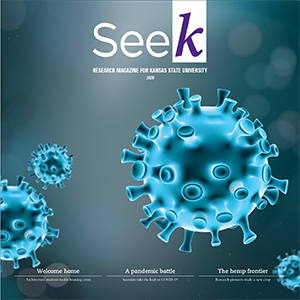Ryszard Jankowiak to deliver conference keynote, visit Japanese institutions
Ryszard Jankowiak, university distinguished professor of chemistry and ancillary distinguished professor of physics, will deliver a keynote address at the 10th Annual Chemistry Congress in Osaka, Japan, in October.Jankowiak’s talk, “Excitonic structure and dynamics in various photosynthetic antenna protein complexes: hole-burning and modeling studies,” will offer insight into electronic structure and excitation energy/electron transfer dynamics in various photosynthetic complexes. For example, in their excited state, electrons in light harvesting antennas of plants and photosynthetic bacteria transfer energy, and Jankowiak’s group works to understand and model these processes, which one day could help researchers imitate the energy transfer and design better artificial systems.
“We want to understand electronic structure and energy transfer processes taking place in nature so people can build photovoltaic devices that mimic natural photosynthetic systems,” Jankowiak said.
Advances in this area are coming in the form of better tools, better methodologies, and more advanced theories.
“The photosynthetic processes are very fast — and scientists have developed better lasers and methodologies to study them — but what is most important is the development of many new theories. In my group, we use a density matrix theory and a new algorithm to fit simultaneously different types of spectra with one set of parameters to understand the electronic structure of these complex biological systems,” Jankowiak said.
His current focus is to unravel mutation-induced effects in various antenna systems and reaction centers and their impact on excitonic structure and relevant photosynthetic processes. Researchers change a single amino acid close to a particular molecule within a complex antenna system, for example, and see how the electronic structure and dynamics are affected.
“It’s like you are looking for a needle in a haystack. It’s not easy to describe very complex biological systems theoretically — you need experimental data, then you model it and see if it makes sense,” Jankowiak said.
Jankowiak collaborates with research groups around the world. While in Japan for the conference, he will also visit two prestigious Japanese institutions. He will deliver an invited talk at Tohoku University in Sendai and visit a colleague who uses time-domain spectroscopy to study photosynthesis, plus he will meet with colleagues and prospective graduate students at the Tokyo Institute of Technology.
“Visiting these two top-level universities in Japan to discuss possible collaborative research and look for students to come to my lab provides exposure that should benefit our research programs at K-State,” Jankowiak said.
Jankowiak’s travel is supported by the department of chemistry and by a Faculty Development Award from the Office of Research and Sponsored Programs in spring of 2017.

